7 Reasons Why You Should Look in Your Baby's Mouth with Dawn Winkelmann, MS, CCC-SLP
- How to use a tongue depressor to search for pocketed food…and why you would want to!
- Which oral structures you should get eyeballs on in your baby’s mouth every month
- What to look for if you suspect a lip or tongue tie…and who to get help from if there is one

LISTEN TO THIS EPISODE
Episode Description
There’s a lot going on inside of your baby’s mouth when they start solid foods. Turns out that looking inside your baby’s mouth can give you a heads up if something is going wrong. Speech Language Pathologist Dawn Winkelmann is here to explain how and why to use a tongue depressor when your baby starts eating.

About the Guest
- Dawn Winkelmann, MS, CCC-SLP is a global expert in baby-led weaning, specialist in pediatric swallowing, award winning product designer and a feeding therapist! She is the product designer for ezpz, having designed their baby-led weaning spoon the Tiny Spoon, the Tiny Cup for babies 6-12 months, their Mini Cup + Straw System and numerous other leading baby-led weaning supplies.
- As a feeding therapist Dawn sees babies with a variety of feeding disorders...many of which are preventable. Listen to learn how to help prevent needing to utilize feeding therapy - but also what to do in the event your baby would benefit from sessions with a feeding therapist.
Links from this Episode
- Ezpz Baby-Led Tongue Depressor, code KATIE10 is here
- Baby-Led Weaning with Katie Ferraro program with the 100 First Foods™ Daily Meal Plan, join here: https://babyledweaning.co/program
- Baby-Led Weaning for Beginners free online workshop with 100 First Foods™ list to all attendees, register here: https://babyledweaning.co/baby-led-weaning-for-beginners
Other Episode Related to this Topic

Latest Episodes
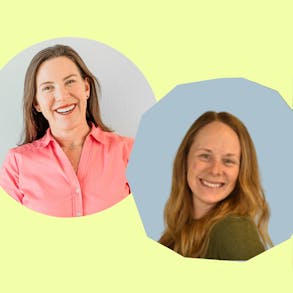
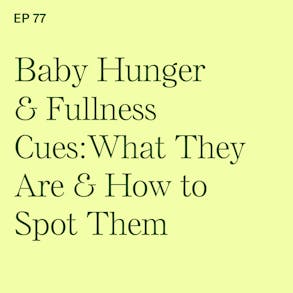
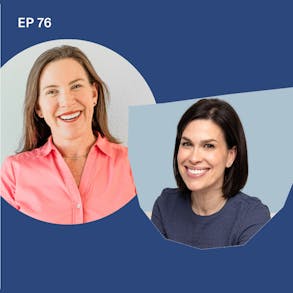
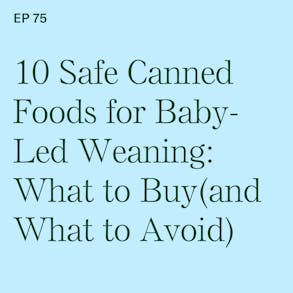
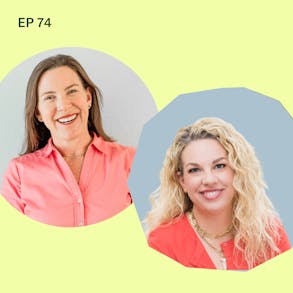
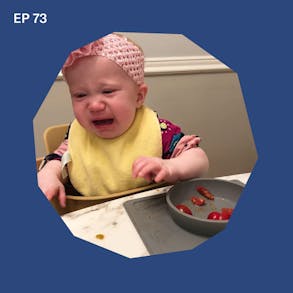
Katie Ferraro (1s):
So which foods are not safe for your baby to eat? You guys know I'm usually all about sharing all of the foods that your baby can safely eat, but there are definitely some foods that we steer clear of when starting solid foods. I have a free feeding guide called 15 Foods Never to Feed that will help you recognize which foods aren't safe. Now most of the foods inside the 15 Foods Never to Feed Guide we avoid because they're choking hazards. But I'm providing you with tips on how to modify those foods so they are safe for your baby to eat. You can download the 15 Foods Never to Feed Free Feeding Guide by going to babyledweaning.co/resources.
Katie Ferraro (41s):
Again, that's babyledweaning.co/resources to download your free feeding guide 15 foods never to feed with the modification tips on how to make those foods safer. Happy feeding. Are you about to start solid foods but you don't know where to start. Or, maybe you started with some purees and now you want to make a switch. The best place to get started. Learning about starting solid foods safely is my one hour online video workshop called Baby-Led Weaning for Beginners. I Just rerecorded this free training and it s packed with videos and visuals on how to safely prep Baby-Led Weaning for Beginners foods, what it looks like for the first few days, how to reduce choking risk and what to do if your baby has an allergic reaction to food everybody on this free training gets a copy of my original 100 First Foods list so you'll never run out of ideas about what to feed your baby.
Katie Ferraro (1m 31s):
Next, you can get signed up for this video workshop at babyledweaning.co. If you have one hour to dedicate to learning about Baby-Led Weaning, come take this free online video training and grab your copy of that original a 100 First food list. While you're there, again, head to babyledweaning.co to get signed up and I hope to see you there.
Dawn Winkelmann (1m 53s):
You need to know if there's an obstruction inside of that mouth or if there's an object. Second would be a tongue, lip or cheek tie. Thrush is another reason we want to make sure that you know, if baby is having a yeast infection on their tongue, if it's like whitish gray, if it resembles cottage cheese, we wanna know that.
Katie Ferraro (2m 12s):
Hey there, I'm Katie Ferraro, registered dietitian, college nutrition professor and mom of seven specializing in Baby-Led Weaning. Here on the Baby-Led Weaning with Katie Ferraro podcast. I help you strip out all of the noise and nonsense about feeding, giving you the confidence and knowledge you need to give you baby a safe start to solid foods using Baby-Led Weaning. So it turns out that there is a lot going on inside of your baby's mouth when they start solid foods. And if you were breastfeeding, I know you have always sensed or felt like, oh, that feels right, or you know when your baby latches on, you're like, yes, that's it.
Katie Ferraro (2m 54s):
Everything is like flowing and going together well, but when they start solid foods, how do we know what's going on in the baby's mouth? Well, it turns out that looking inside your baby's mouth is a pretty good way to give yourself a heads up if something is going wrong or if everything is going smoothly today, the speech language pathologist, Dawn Winkelmann is back on the podcast here to explain how and why to use a tongue depressor when your baby starts eating solid food. And first of all, I was gonna call this episode 3 Reasons Why You Should Look in Your Baby's Mouth with Dawn Winklemann. And then of course when she got on the interview she's like, I can't stop at three. I have way more. So we have seven reasons why you should look in your baby's mouth and listen to this episode to learn how to use a tongue depressor to search for pocketed food and why you would even wanna do that, which oral structures you should be getting eyeballs on in your baby's mouth every month.
Katie Ferraro (3m 45s):
And then what to look for if you suspect your baby has a lip tie or a tongue die. And then where to get help and who to get it from if there really is such a thing. Now tell you a quick little backstory. Dawn is one of my dearest friends, my Baby-Led Weaning bestie, and when she told me she was making a tongue depressor, I was like, you are off the rails like you're supposed to be making feeding gear. What are you doing with a tongue depressor? I am totally convinced I have started doing this. I'm a dietitian, I'm not a speech language pathologist, but there's a lot of things that you can tell about a baby's ability to eat by looking in their mouth and using a tongue depressor and using the right kind of tongue depressor is a really good idea. So I originally might have snark on her idea of the tongue depressor, but I absolutely love it.
Katie Ferraro (4m 28s):
I think this is such an incredible tool. I was just working with a mom who's been using it extensively as well and we were talking about, we kind of covered that in this episode as well, but like how even if you're not an SLP, you're not a dietitian, you're not a pediatric dentist, there's a lot of stuff you can learn about your baby by looking in their mouth and it can help alleviate a lot of stress for you too. So I hope you guys enjoy this interview with Dawn Winkelmann. If you wanna check out the baby-led tongue depressor that she designed for EZPZ, it's online at ezpzfun.com, you can use my affiliate discount code KATIE10 to get 10% off all of the feeding gear. And now the oral care and pre feeding tools that Dawn and her team at EZPZ are making.
Katie Ferraro (5m 15s):
Here's Dawn.
Dawn Winkelmann (5m 16s):
I was on my way to a client's house and the mom calls me on the cellphone. I was going there to do some feeding therapy and the mom calls me on the cellphone and she's just like, Dawn, I think there's something in the back of my baby's throat. I think it's chicken don't know what to do. And I said, well, you're CPR trained. Is she breathing? Is everything going smoothly? And she's like, yes, yes. And I'm like, I'm, I'm five minutes away, I'll be there in a second. Get there, go in and she's like, look, look, there's something in the back of her mouth. And I take my tongue depressor and I look into the baby's mouth and I'm like, oh, that's called a uvula. That is basically the back of the throat. If you've ever seen like a Charlie Brown cartoon and you see this ah, hanging teardrop shape piece of tissue that hangs down from the soft palate in the, the back of the throat, that is normal anatomy.
Dawn Winkelmann (6m 1s):
And the mom thought it was a piece of chicken stuck in the back of her throat and she was like, she was frantic and she was like, I didn't know if I should get like, you know, you know, pluck it out with some, you know, with tweezers, should I, you know, take it out with tweezers? And I was like, no, that is actually part of your baby's anatomy. And she had never looked in her baby's mouth before. So here she is thinking that the baby's choking on chicken and that there was a piece of chicken in the back of her throat and it was actually part of your baby's anatomy and physiology. And so it was just a wonderful wide opening experience for me to, to say like, parents should look into their baby's mouth with a tongue depressor and do an oral assessment every single month so they can see babies developing oral cavity.
Katie Ferraro (6m 47s):
Dawn, you have been on this podcast before talking about topics like pocketing and how babies learn to chew and swallow. And I'm sorry, but as interested as I am about what's going on in a baby's mouth, like as a dietitian and a mom, I am not always inclined to go poking around and looking in there. So can you give me some reasons why parents who are not speech language pathologists might be interested in or inclined to look in their baby's mouth?
Dawn Winkelmann (7m 13s):
There's so many reasons. One reason is to look at oral structures and the example that I just gave. You know, you need to know your baby's oral structures. You need to know that for safety reasons. You need to recognize the changes in your child's mouth so that you could, you know, go to another pediatrician or to be able to go to a dentist for you to be able to know what the next plan of care is. You need to know if there's an obstruction inside of that mouth or if there's an object. So many times I've actually taken coins out of a child's mouth or toys that have been left over because every time I go to feed a baby, I look into their mouth before I feed them because again, it is so important for us to make sure that we have a clear oral cavity before anything gets put into their mouth.
Dawn Winkelmann (7m 60s):
Liability issues for one, but also two, the safety issues of a child. Second would be a tongue, lip or cheek tie. You know, parents are the ones that are usually telling us medical professionals, Hey, I think my baby's tongue, it just feels really thick. Or my baby's tongue is heart shaped. They're explaining the characteristics of those types of symptoms. And so we want them to go into the mouth and actually look at that. So many times that, you know, tongue ties and then eventual tongue tie releases happen is because the parent looked into the mouth and assessed it. So thrush is another reason. We want to make sure that, you know, if baby is having a yeast infection on their tongue, if it's like whiteish gray, if it resembles cottage cheese, we wanna know that as a feeding therapist.
Dawn Winkelmann (8m 47s):
I want to know if this, if this baby's having thrush, they might not be able to eat as much. They might, you know, their senses is changing, they might have to increase the sensory exposure to that food to make that safer for them. It could cause more gagging. We need to know that. So if a parent is like, oh my baby's gagging more this meal, I don't know why. Well if they haven't looked into their mouth, these could be some of these potential reasons. Emerging teeth is another one. If the baby is drooling a little bit more, why is baby drilling more? Do we have some emerging teeth? You know, some babies are born with teeth, so it's like we have to look into the mouth and, and kind of assess that. Some people I've worked with kids that they don't even have a tooth and they're going on their second birthday.
Dawn Winkelmann (9m 30s):
Like that's unusual. Like we need to look into the mouth and kind of see that illness. Does a child have redness or white in the back of their throat? Is it strep throat? Is baby having an allergic reaction to some of those foods? We'll see those structures kind of swell up and parents won't know that if they're not familiar with, with their mouth. Childhood early, childhood caries as an as another one, we want to know that, that the teeth that are emerging is not actually having some oral issues. And parents, again, are the first ones to kind of alert their pediatric dentists that this is what they're kind of seeing pocketing.
Dawn Winkelmann (10m 10s):
So, you know, a lot of times parents don't know that the baby is pocketing unless they look into their mouth. And sometimes it's really hard to tell pocketing as we've talked about in previous episodes, can be inside the cheek. It could be underneath the the lip, it can be underneath the tongue, it could be up to the roof of the mouth. There's lots of little cavities in the mouth that we, you know, need to look in and, and check for pocketing. It's very easy to be able to do that with the tongue depressor. So we want to be able to kind of assess that from a home visit kind of standpoint that parents can do this at home. But also as you're doing that and doing an oral examination every single month of your child's life, you're also preparing them for other medical visits.
Dawn Winkelmann (10m 53s):
You know, your pediatrician's gonna use a tongue depressor on your kids. Your pediatric dentist is gonna use a tongue depressor on your kids. So this is allowing them to, to have a better experience in those medical procedures. Less battles, crying, less behaviors, less embarrassment for parents and being a rockstar. How wouldn't it be cool to have your pediatric dentist going, wow, your child is a rockstar. She was able to do this oral assessment so fast, or have the pediatrician goes, oh my gosh, you know, it was so easy to diagnose hand foot mouth disease for your child because they knew what a tongue depressor was like. So it, it's just, it's for health and wellbeing and you know, this really, this preparation kind of starts at home.
Katie Ferraro (11m 35s):
Hey, we're gonna take a quick break, but I'll be right back.
Ritual (11m 43s):
This episode is sponsored in part by Ritual prenatal vitamins. Are you still taking your prenatal vitamin? As a dietitian, I know I always continued my prenatal even after I gave birth. In fact, the World Health Organization recommends continuing your prenatal until you start weaning. But not all prenatals are created the same. And Rituals essential for women. Prenatal supplements contain science-backed formulas, third party testing for heavy metals and microbes, as well as traceable ingredients. Ritual essentials, prenatals support a healthy pregnancy with key nutrients that your body and your baby's body needs. Like methylated folate and nature identical choline that supports your baby's neural tube development, as well as Omega-3 DHA for brain and early vision development and vitamin D that supports fetal bone health. All ritual products are rigorously tested and they're clean label project certified. You deserve to know exactly what you're putting into your body, especially when it comes to prenatal vitamins and with Rituals, dedication to traceable science and sourcing. You always will see for yourself with 25% off your first month at ritual.com/weaning start Ritual or add essential for women prenatal to your subscription today. Again, that website is ritual.com/weaning for 25% off.
Katie Ferraro (13m 12s):
Dawn, you recently designed the baby-led tongue depressor for EZPZ. Please tell me what parents use this product for and when do they start using it. And then do you have any best practices or tips for success when using a tongue depressor with your baby?
Dawn Winkelmann (13m 28s):
Yeah, I've taught medical professionals and parents to use a tongue depressor and feel confident and safe in having this being a part of their routine. I coined the term baby-led oral care as a way to kind of show families the fundamentals of Baby-Led Weaning and how they can extend to oral care. Because when you start out with baby-led, meaning babies are interested at first for short periods of time and maybe they're not as successful, you know, the first couple of meals, well the same thing goes with using a tongue depressor. You know, the baby might not be interested as much, maybe you're only getting an assessment that's like five seconds. But as it becomes more of a routine, it becomes easier for the child to have this be part of their monthly, weekly, or daily routine that they're able to kind of look in.
Dawn Winkelmann (14m 17s):
We want to do these quick, you know, five seconds or five minutes oral regimens so that you know, if your baby starts to crawl or starts to walk and they faceplant and they hit their mouth that you, it's easy for them to allow you to go into the mouth and kind of assess that tongue Depressors are always in medical settings and I want them to be in homes, right? I want them to be able to feel comfortable and, and feel successful with looking into their baby's mouth. Every time I teach a parent to use a tongue depressor to look into their mouth, they're so nervous and I'm like, your breast has been in this mouth like you, this is the same mouth that you were feeding with your breasts and now you're gonna start solids and you want to look into the mouth again and like, and kind of assess this.
Dawn Winkelmann (15m 9s):
And so I, I like showing parents like the tongue depressor that that they're normally seeing and the tongue depressor that I designed, you know, this is basically it's a regular tongue depressor for your listeners is made outta birchwood and it sucks out all of the saliva and moisture out of the mouth. So as soon as it goes into mouth, it's drying out my tongue to where I don't have saliva. And as we're assessing the structures, you know I'm looking at the palate, I'm looking at the tongue, I'm looking underneath the tongue, I'm looking into the cheeks. It becomes very uncomfortable for kids because this is just kind of a little sharp and it's hard to manipulate and it's again sucking out all that saliva.
Dawn Winkelmann (15m 56s):
Why I designed the sensory tongue depressor is that it's stainless steel with silicone overmold. So it makes it very easy to go into the tongue using that saliva as a way to kind of glide the tongue depressor through the mouth, making it very easy for parents to be able to look at structures and the sensory bumps that are on the sensory tongue depressor, grab a hold of the tongue and make it very easy to kind of move those structures so parents can see. Whereas with a, with tongue depressor, it's very difficult to do that 'cause the tongue depressor gets stuck and then you're kind of like hurting the tongue as you move it.
Katie Ferraro (16m 29s):
I get goosebumps when you even talk about wood tongue depressors like that is like not what I want in my mouth. Is this the first non-wood tongue depressor? Were there other alternative materials?
Dawn Winkelmann (16m 40s):
There are plastic tongue depressors out there. I also don't want.
Katie Ferraro (16m 44s):
Plastic in my baby's mouth. Sorry.
Dawn Winkelmann (16m 46s):
And the disadvantage of those is that the plastic tongue depressors as the child is, you know, putting their mouth on it or teeth on it, they're ingesting plastic strips. It's really important for people to know that those microplastics can occur with that. Another beautiful thing about the sensory tongue depressor is that you can put it into a cup of warm water or you could put it in a cup of ice water and it will hold a temperature for 60 seconds. So with my babies, this is really important, I'll put that into warm breast milk. And so the sensory bumps hold onto that breast milk. So the baby's tasting that breast milk more likely to open up their mouth again, adding that sensory capability in there.
Katie Ferraro (17m 29s):
Dawn, I know speech language pathologists like yourself, especially in feeding therapy, you're gonna use tongue depressors and you guys use them in speech therapy as well. And we generally talk about infant feeding on this podcast, but you've taught us that helping your baby meet certain feeding milestones can in turn help them develop the language milestones that are coming a little bit later. So can parents use the tongue depressor for any speech related activities at home with their baby? And if so, how?
Dawn Winkelmann (17m 56s):
Yeah, well we can absolutely use it for all things feeding, but also speech as well. It's the same structures, right? So what we're trying and so it's like I'm working with the tongue depressor for feeding. I'm working for the tongue depressor for oral motor skills. I'm working for the tongue depressor for sensory skills. I'm working for the tongue depressor for respiratory skills, right? Feeding is all about respiration. Speech is all about respiration. So I want to put the tongue depressor on the in between my lips or in between the child's lips and hold it so I'm working these muscles. But also as the child is holding this weighted tongue depressor between their lips, they can't help but breathe through their nose.
Dawn Winkelmann (18m 36s):
This is how I find a lot of my kids that have airway issues, they're putting it between their lips, especially if it's like a six month old baby and they're kind of holding it and playing with it and then all of a sudden they're like gasping. I'm like, Ooh, I need to send you to an airway dentist because I can already tell that we're having some difficulties with respiration, which means we're gonna have difficulties with respiration, with food, and we're gonna have difficulties with respiration, with speech production.
Katie Ferraro (19m 1s):
Hey, we're gonna take a quick break, but I'll be right back.
Priceline (19m 10s):
Hey, it's Kaylee Cuco for Priceline. Ready to go to your happy place for a happy price. Well, why didn't you say so? Just download the Priceline app right now and save up to 60% on hotels. So whether it's cousin Kevin's kazoo concert in Kansas City, go Kevin or Becky's Bachelorette Bash in Bermuda. You never have to miss a trip ever again. So download the price line app today. Your savings are waiting, Go to your happy place for a happy price, go to your happy price Priceline.
Katie Ferraro (19m 43s):
Dawn, you've shown us that looking in your baby's mouth is important for a number of safety and development reasons, but how do you know if what you're seeing requires further exploration or intervention by a specialist? Basically, what sort of stuff, if you saw it in your baby's mouth, would you recommend, oh mom, dad, you should get a referral to an SLP or a pediatric or an airway dentist?
Dawn Winkelmann (20m 7s):
Yeah, I'll just give you some examples that I've had with the families that I've worked with. I've had parents look into the mouth and like say, Hey, I think my baby has a high palate, you know, can you look? What do you think? And then I'm like, oh yeah, they do have a high palate, or my baby has sores inside of their mouth, or they have lip blisters. And a lot of these, you know, oral structures and symptoms in there are symptoms of like a lip tie or a tongue tie or hand food mouth disease. So then I will say, oh, you know what? I think that you should go see your pediatric dentist or your pediatrician. But parents are the ones that are looking into the mouth using, you know, the sensory tongue depressor and finding this if they are looking into the mouth and concerned about the lip tie or a tongue tie or maybe that might be tight, they're using tho that terminology.
Dawn Winkelmann (20m 58s):
Again, I'm referring them to an airway specialist. I am talking to them about the difference between airway dentistry and pediatric dentistry. If they have thrush or childhood carries, right? So I'm like, oh, you need to go follow up with your pediatrician or you need to make an appointment. Usually we try to make an appointment with a dentist at the first tooth or by at least by a baby's first birthday. But I might say, Hey, you know, with some of these symptoms that you're talking about, you might want to make an appointment with your pediatric dentist a little bit earlier. Or if they have pocketing of food or if they're just like, I look in the mouth and I feel like my baby has a hyper gag reflex or I feel like my baby isn't swallowing when I look into the mouth, I, I see food still back there, then that would be a referral to a speech pathologist or occupational therapist.
Dawn Winkelmann (21m 45s):
So a lot of the information that parents can glean from using a tongue depressor can actually help get the right medical providers into their baby's life and really stop any delays that can come up from some of those things that they're seeing. And I just wanna empower parents like you are the one that knows your baby best. You're the one that is able to look into the mouth every single day and and being able to kind of see what's happening. And 99.9% of the time parents asking those questions about their child's mouth helps them get early intervention so much faster and really can decrease the fact that you would need speech therapy or, you know, in some cases braces in the future or airway problems or you know, surgeries like a tonsillectomy or something like that.
Dawn Winkelmann (22m 34s):
It, it's really empowering for parents to really be an advocate for their oral health and to really help them succeed with oral care and feeding.
Katie Ferraro (22m 42s):
Dawn, thank you so much for sharing your time and your expertise here, and you have definitely inspired us to all be a little bit more vigilant about searching around in our kiddo's mouth. Where can our audience go to learn more about your work and to support your business?
Dawn Winkelmann (22m 56s):
Oh, thank you. They can get some of the products that I designed for EZPZ at ezpzfun.com and use the code KATIE10 for 10% off. They can also find me on social on at Miss Dawn SLP. That's M-S-D-A-W-N SLP.
Katie Ferraro (23m 14s):
Okay, what do you guys think? Are you converts? You gonna start using the baby Led Tongue Depressor? If anything, I'm never gonna put a wooden tongue depressor in my baby's mouth. I keep getting goosebumps every time she was talking about it. And we did some video stuff for this interview too, and she was like showing the tongue depressor. Her tongue depressor is very cool and I can attest to it being much more effective at figuring out what's going in your baby's mouth and just kind of guessing or using your fingers. So check out all of the resources that Dawn included in today's episode. Those will be on the show notes at blwpodcast.com/452. And a special thank you to our partners at AirWave Media. If you guys like podcasts that feature food and science and using your brain, check out some of the podcasts from AirWave, we're online at blwpodcast.com.
Katie Ferraro (24m 2s):
Dawn's at Miss dawn SLP EZPZ is ezpzfun.com and my EZPZ discount code is Katie10. If you wanna get yourself a baby-led tongue depressor and start looking around to see what's going on in there, it's actually very fascinating. Bye now.
Culture Kits Podcast (24m 22s):
Ever dreamed of traveling the world with your children without leaving your home? Tuning to Culture Kits podcast to embark on an incredible adventure right where you are. At Culture Kits, we collaborate with cultural organizations, authors and educators from all over the world to expand our children's horizons, inspiring them to embrace our differences while bridging communities worldwide. And that's Culture Kids Podcast. Here's your passport, let's go Home.

The Program Baby-Led Weaning with Katie Ferraro
A step-by-step digital program for starting solid foods safely and navigating the original 100 FIRST FOODS™ meal plan with baby-led weaning.
 EXPERT-LED, PROVEN APPROACH TO EATING REAL FOOD
EXPERT-LED, PROVEN APPROACH TO EATING REAL FOOD CONCISE VIDEO TRAININGS TO MASTER BABY-LED WEANING
CONCISE VIDEO TRAININGS TO MASTER BABY-LED WEANING 100 FIRST FOODS DAILY MEAL PLAN WITH FOOD PREP VIDEOS
100 FIRST FOODS DAILY MEAL PLAN WITH FOOD PREP VIDEOS
Baby-Led Weaning for Beginners Free Workshop
Is your baby ready to start solid foods, but you’re not sure where to start? Get ready to give your baby a solid foundation to a lifetime of loving real food…even if you’re feeling overwhelmed or confused about this next stage of infant feeding.
Get baby-led weaning recipes and tips delivered to your email inbox.

